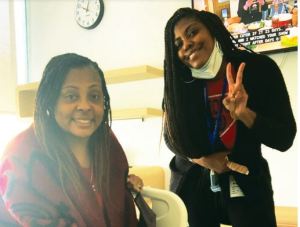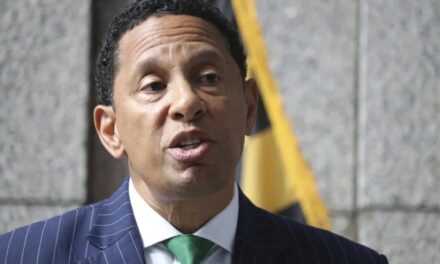

D.C. Editor Micha Green, right, with her mother Bishop-elect Paula Clark as she was released from a rehabilitation center in Chicago in May 2021. (Photo by Micha Green)
By Micha Green
D.C. and Digital Editor
mgreen@afro.com
The past five months I have been in or around a healthcare setting almost daily. My mother suffered a ruptured brain malformation in early April and has undergone several brain procedures and is still doing rehabilitation, I had minor finger surgery in late April and my stepfather has been in the hospital (and briefly a rehabilitation) over month after learning he is in the last stage of a sudden battle with cancer.
Yes, my 2021 has been rough. I’ve cried countless hours, heartbroken about watching the people I love struggle and suffer. My life as a single millennial with only personal responsibilities was changed in an instant. I became a caregiver and advocate for my mother, who has consistently cared for me and been my rock. While my mother still is working to improve, I now have the added responsibility of caring and advocating for my stepfather.
As a caregiver, I get an up-close and personal view of the healthcare system and how people are treated. I’ve had the added benefit, if you can call it that, of seeing how healthcare works in Chicago and its suburbs, where my mother has been treated, in comparison to the care my stepfather has received in the Washington Metropolitan Area.
Before we can even get into the nitty gritty of what I’ve witnessed, I should explain that my experience as a Black woman in the United States begins with having grown up in the D.C. area. Washington, D.C. was once known as “Chocolate City,” and even though gentrification and displacement has the nation’s capital looking more like a “chocolate and vanilla swirl,” there is still a Black Mayor in a locale with a lot of Black people and in an area that claims to cherish and honor its residents of color.
When I arrived in Elk Grove Village, a suburb of Illinois, where my mother was being treated for her AVM, I saw one other Black person at the hospital. He was also a patient. In my time here, I remarked at seeing two other Black people who worked in the hospitality and culinary staff, one other Black nurse on my mother’s floor, and her last day at the hospital we learned the president and CEO of the facility was a Black man and grew up outside of Baltimore, about 45 minutes from where I lived in D.C.
According to research, Elk Grove’s Black or African-American population is a bit over 1.62%. Having come from Washington, D.C.’s majority African-American population at 43%, according to DC Health Matters, Elk Grove Village was a bit of a culture shock. Having gone to predominantly White institutions (PWIs) for undergraduate and graduate schools, I had experienced my fair share of times being one of the few Black people in the room. Still, I immediately knew I was walking into a situation where I had to be my mother’s advocate.
I had read and reported on stories where Black people, and women in particular, were discriminated against in hospital settings, and in some cases those instances were fatal.
Susan Moore, a 52-year-old Black physician, died in December of 2020 after alleging mistreatment from her White doctor and medical team. Moore told her medical team she knew she was experiencing severe complications and needed specific treatments, but instead she was met with resistance, told she did not need painkillers and given the boot home. Twelve hours later she had to call an ambulance to be rushed to a different hospital and she died a couple of weeks later from complications.
Medical News Today reportec that there is implicit bias in the healthcare system and cited a 2016 study where many White medical students incorrectly believed that Black patients had a higher pain tolerance than White people and of all participants, 73% held at least one false fact about the biological distinctions between races.
A 2016 study also found that Black people are 1.26 times more likely to die in a hospital setting than White patients.
I was not going to let my mother be part of those numbers and even despite major advocacy and being there as soon as visiting hours began until the nurses kicked me out, my mother still experienced discrimination.
When my mother was first rushed by ambulance to the hospital, her complaints about double vision, extreme head pain and nausea were minimized to dehydration, until her best friend, a Chicago physician, had to advocate for her getting a CAT scan. At the hospital in Elk Grove Village, she was ignored for over an hour when calling for nurses, her claims of pain were sometimes trivialized and sometimes the bedside manner was less than hospitable.
To my mother’s chagrin, as she wanted to stand on her own power and value, myself (and others on her staff), made it known that patient Paula Clark, was actually the first Black woman to be elected Bishop of the Episcopal Diocese of Washington.
Soon things and treatment changed. Charge nurses began to speak to us personally, administrative staff went out of their way to visit her, and the president of the hospital personally visited her the day she was discharged. People joked she was the hospital celebrity. However, there were still times where I had to chase after nurses to make sure they took her request to use the bathroom seriously, had to remind the staff she was deathly allergic to carrots and the skin of most fruits when they would bring her meals, and take urgent assistant needs in my own hands when no professional could be found.
Through challenged speech and mobility, my mother emphasized to the Black president of the hospital how sad it was that it took us telling them of her dignitary status for her to be treated in a dignified manner.
“Every patient should be treated equally,” my mother told him. “We have a lot of work to do,” she added passionately.
Upon discharge from the hospital, my mother became an inpatient at one of the premier rehabilitation centers in the country, located in Chicago.
Now having a facility to compare it with my stepfather’s rehabilitation stint in the D.C. area, the Chicago rehabilitation center was truly top-notch aesthetically. The building and rooms were much nicer and modern and the facilities were top of the line. The place was bright with beautiful decor and the auro was welcoming with fresh air as opposed to the all-too familiar smell of sickness and struggle in the air at many healthcare facilities.
Further, there were far more Black people in Elk Grove Village. Most of the Black people were nursing assistants and had direct contact with my mother, so I was not as worried about the racial healthcare discrimination.
However, the treatment was not always top-notch. In the beginning of her stay, she was ignored once for over two hours when pressing the nurse’s call button, she was admonished and left precariously after a fall and the culinary team constantly brought food to which she was allergic. We challenged the staff at times asking why that rehabilitation was so particularly touted as “the best.”
Soon into her rehabilitation stay, against her wishes, my mother’s work staff and myself told the center her full title and things changed. One of the head doctors attended a church in the Episcopal Diocese of Chicago, others were moved by her story and inspired by her strength.
Nonetheless, some healthcare challenges continued. I waited at the rehabilitation, sometimes over two hours late into the night, as we begged the staff for someone from the respiratory department to come set up her sleep machine. It was a week before someone finally thoroughly cleaned my mother’s room and bathroom, and that was after I begged for days. Finally, one doctor had to admonish the staff and pick up trash herself before the cleaning request was met.
People kept saying to me they wondered what my mother’s experience would have been had she not had me as an advocate. I didn’t have to wonder as I saw firsthand what she could have faced. The few Black patients I saw in both facilities were often lonely and I rarely saw nurses going into their rooms except to take their vitals. Sometimes I heard screaming and arguing as the patients tried to advocate for themselves. Sometimes I heard tears as patients sat in misery with unmet needs.
During my mother’s stint in the hospital one healthcare professional, who was not treating my mother, actually told me I “should lower my expectations,” as my mother was not the only patient.
How about we elevate the healthcare expectations? How about people being treated as humans during the hardest times of their lives?
Despite the challenges in the Windy City, the maltreatment I have witnessed towards Black patients in the Washington Metropolitan Area has been disgusting and disappointing over the past month.
Even with the many people of color working all over the hospital settings in the D.M.V.- from doctors to techs, my stepfather has received subpar care. He was poked, prodded and not fully given a diagnosis after two weeks in one hospital and then released to a rehabilitation for physical therapy without any explanation as to how doctors planned to treat his cancer. The first hospital made a major mistake in one procedure, causing challenges that had to be corrected by another hospital.
He spent two weeks in a rehabilitation facility filled with staff from the African diaspora in a building that was nowhere near as clean, well lit or nice as the one my mother experienced in Chicago. There, they sometimes belittled his nourishment and health concerns. Labor Day weekend his blood levels were low and the doctor recommended a multivitamin as opposed to accessing him further or sending him to the hospital.
Four days later they released him to my care for a doctor’s appointment and I, a lay person, noticed in the first few minutes of driving with him that he did not need an oncologist, but an emergency room (ER). When we got to the ER I ran into the facility for assistance and a Black worker first came alone after underestimating the severity of my pleas. He then took one look at my stepfather and misconstrued his heavy breaths and disoriented symptoms as complications from COVID, and challenged my mother when she tried to tell him that was likely not what was ailing him. It took Black women coming and assisting my stepfather before he was taken seriously, taken on a gurney, and ultimately admitted into the intensive care unit.
My family later learned that if I had not taken him to the emergency room, he would have died minutes later.
How does a healthcare setting and an entire medical team miss what a lay person noticed in moments?
Later, in the same ER where I had just taken my stepfather hours before, I witnessed two Black workers ignore a fellow Black man who was bleeding profusely. After minutes, a White nurse surfaced, looked at the man and announced with a smug look, “We have a GSW (gunshot wound),” and instead of someone coming to help the man, the workers yelled, “Oh, come on,” and signaled him in.
How does a man experiencing complications from a gunshot wound get ignored and maltreated in a hospital setting? Being Black.
Black pain is not taken seriously and undervalued. Pain and struggle has historically been part of the Black experience, but it bleeds into the very system that is supposed to bring help, alleviation and strength.
Even in cases of emergency, such as with my stepfather and the man who was shot, the downplaying of Black pain is commonplace.
A 2020 study showed that between 2005 and 2016 medical professionals were 10 percent less likely to admit Black patients than White people complaining of ailments.
The history and generations of mistreatment in medical environments is one reason why Black people have such distrust when it comes to healthcare professionals and settings. However current research and my firsthand experiences show that racial discrimination in healthcare settings is still a major challenge that must be addressed.
Help us Continue to tell OUR Story and join the AFRO family as a member – subscribers are now members! Join here!
The post Black and sick: What I’ve witnessed while in the hospital appeared first on AFRO American Newspapers .











